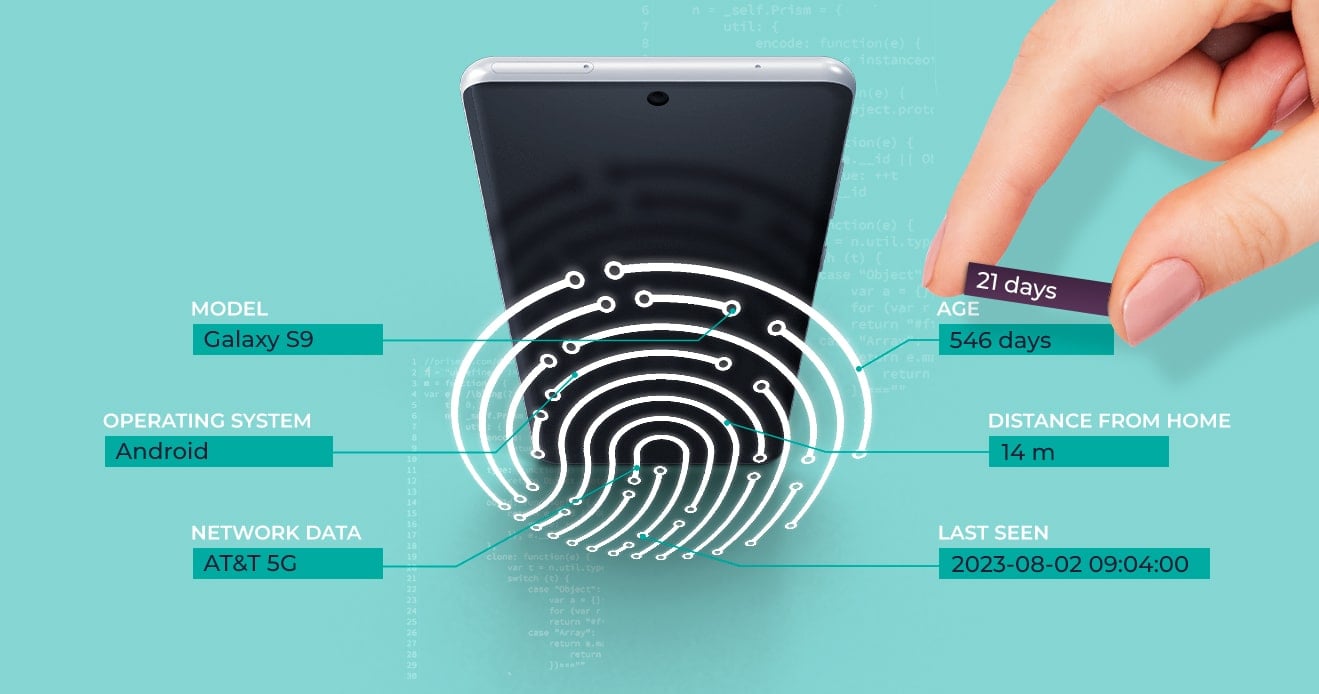- Blog
- A Comprehensive Analysis of Device Fingerprint Spoofing Techniques
A Comprehensive Analysis of Device Fingerprint Spoofing Techniques
The Evolution of Device Fingerprinting: From Cookies to Spoofing Techniques
Subscribe to the Incognia Newsletter
Device fingerprinting is the process of collecting unique information from a device to create a fingerprint you can use to uniquely identify that device—just like human fingerprints uniquely identify each of us. This information includes a device’s attributes, hardware, software, location, and behavior.
However, as device fingerprinting has become more prevalent, privacy-oriented users and bad actors have found ways to avoid being tracked. One powerful way to disrupt device fingerprinting is to use fingerprint spoofing techniques—techniques that manipulate the information taken in by device fingerprinting technology in order to create a false image of the device.
If you compare it to a real-world human fingerprint, fingerprint spoofing would be like criminals changing the individual whorls on their fingertips to avoid being linked to a crime scene.
Fingerprint spoofing presents fraud fighters with an interesting dilemma: How can you accurately identify individual users when you know that the device data you collect for this purpose may not always be trustworthy?
To understand how to tackle this problem, we have to first understand what these spoofing methods are and how they work.
Key TakeAways
- Device intelligence can be a valuable tool in the fight against fraud, but fraudsters can easily spoof legacy device fingerprinting solutions
- Factory resets, third-party tools, and the manipulation of device attributes are just a few fingerprint spoofing methods
- Combining next-generation device intelligence with additional signals like location makes for a more persistent, tamper-resistant signal
The history of device fingerprinting: then and now
Device fingerprinting technology has its roots in the early 1990s when the Internet was still in its infancy. Initially, cookies were the primary means of monitoring users online. As early as 2005, device fingerprinting began to emerge as a more advanced and reliable method for identifying and monitoring users.
The advent of Flash and JavaScript around this time paved the way for the growth of device fingerprinting, as these technologies enabled more detailed collection of information about a user's device.
As more sophisticated browsers and devices entered the market, the depth and uniqueness of the available data increased, enhancing the accuracy of device fingerprinting. In 2010, a seminal study by the Electronic Frontier Foundation titled Panopticlick demonstrated how effective browser fingerprinting could be.
With the proliferation of smartphones and tablets in the 2010s, device fingerprinting expanded beyond browsers to include various device-level data points. Today, with the rise of the Internet of Things (IoT), the technology continues to evolve, incorporating data from a plethora of interconnected devices.
However, as device fingerprinting technology evolves, so do the countermeasures fraudsters use to outfox it. Even despite its power and accuracy, the race to keep up with fraudsters shows us that device fingerprinting isn’t the same solution it used to be—at least not when used in isolation.
What are the different device fingerprint spoofing techniques?
Device fingerprinting is a commonly used tool in the fraud fighter’s arsenal, but it’s far from foolproof. Fraudsters have become experts at cloaking their digital tracks, using both simple tricks and advanced tools to manipulate or erase identifiers. .
1. Factory resets
This is by far the simplest method of evading device fingerprint. Performing a factory reset on a device—that is, removing all of its data and restoring it to its original factory settings—allows fraudsters to continue using that device on a particular platform even after it’s been flagged by that platform as being associated with fraud. Traditional device fingerprinting solutions are unable to re-identify devices that have been factory reset.
On most devices, resets are as simple as navigating to a “factory reset” or “erase all data” button in the settings menu. Resetting a device doesn’t require any special tools, resources, or technical knowledge.
2. Third party apps and plugins
Some third party apps can thwart device fingerprinting, particularly when it’s done on web browsers (otherwise known as browser fingerprinting). This is another simple solution for those without much technical knowledge. These apps allow users to select which device or browser attribute data they’d like to change, including font, timezone, screen resolution, and so on.
Though these tools are officially marketed towards privacy-concerned users looking to avoid monitoring by advertisers, they can also be incredibly useful for fraudsters looking to avoid accountability.
3. Changing device attributes like device ID
The same sort of device attribute switch-arounds that third party apps can do are also possible for more technically knowledgeable actors to do manually. Because device fingerprinting uses information like IP address, operating system, software versions, apps, and screen resolution to identify devices, manipulating these attributes periodically can help obfuscate a device’s identity.
4. Presenting a false user agent (UA) string
User agent strings help servers determine what type of device and browser users are accessing their app or website from, allowing them to return content appropriately. For example, it would be inconvenient if, every time you accessed a website on your desktop computer, there was a chance that you would accidentally be given the mobile version of the website instead. User agent strings help prevent this by giving the site or app server some information to go off of.
Because of the data it provides about operating system, device type, and browser, user agent strings are also helpful tools for device fingerprinting. When someone spoofs their user agent string, they can provide false information about these attributes and manipulate their data to make it look like multiple requests from a single device actually come from multiple devices.
How does device fingerprint spoofing detection work?
Because of the spoofing tactics outlined above, device fingerprinting alone often can’t be trusted. But platforms can take a stronger approach by combining device intelligence with a second, tamper-resistant signal. Incognia does this by pairing device intelligence with location intelligence.
Consider this example scenario: A fraudster is trying to abuse new user promotional discounts on a food delivery app. She’s repeatedly factory resetting her device to change her device ID so that she’ll look like a novel user each time.
If a traditional device fingerprint was the only signal the app had to detect individual devices, there would be little they could do to stop this promo abuse. In fact, they might not even be able to identify that it was happening; they’d just see what looked to them like many different devices.
By introducing a signal like location intelligence, fraud prevention teams gain a more persistent view of user activity. Geolocation data could reveal that all this behavior was actually coming from the same person on the same device — regardless of how often it had been reset or spoofed.
By combining signals like GPS, WiFi, and Bluetooth, it’s possible to create a unique image of a device’s location with a false positive rate of less than 1%. This accuracy makes it incredibly reliable for re-identifying devices.
In addition to using a signal like location intelligence, platforms can also perform device integrity checks to search for signs of tampering — such as rooted devices or known spoofing apps and plugins. These checks can help weed out bad actors earlier in the user journey.
Device fingerprinting is a widely used method among apps, advertisers, and even law enforcement agencies to track devices and user behavior. But as bad actors have learned how fingerprinting works, they’ve also learned how to exploit its weaknesses — making it easier to manipulate or evade.
When modern device intelligence is combined with location intelligence, the result is a highly resilient and persistent signal. This pairing offers a critical advantage against fraud tactics like spoofing, resetting, and device manipulation.
It’s clear that traditional device fingerprinting has reached its limits. But combining modern device intelligence with other strong anti-fraud signals allows platforms to hold fraudsters accountable and protect their good users from abuse.
To learn more about how Incognia is building next-generation device intelligence for web and mobile, visit our device intelligence page.




